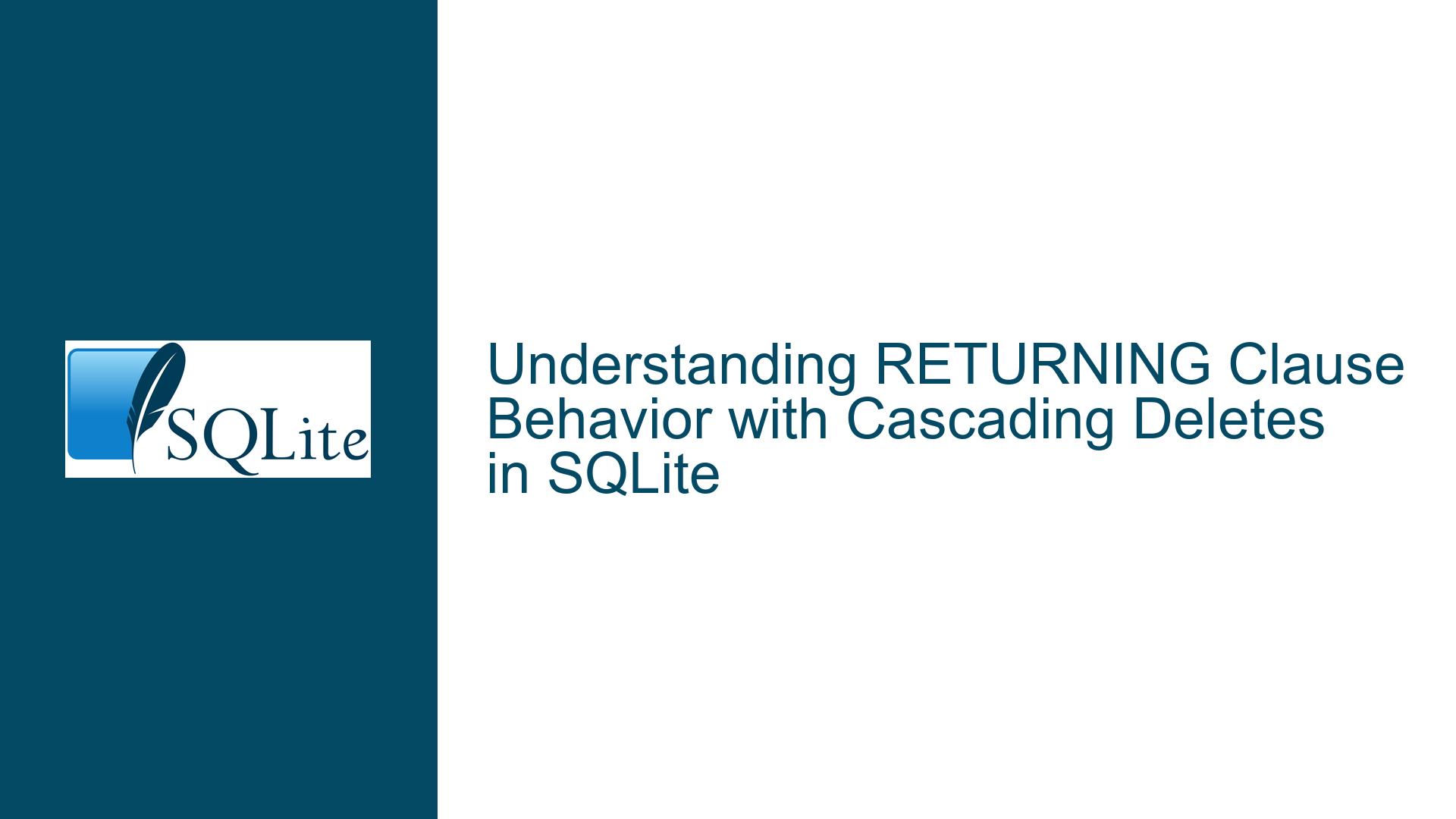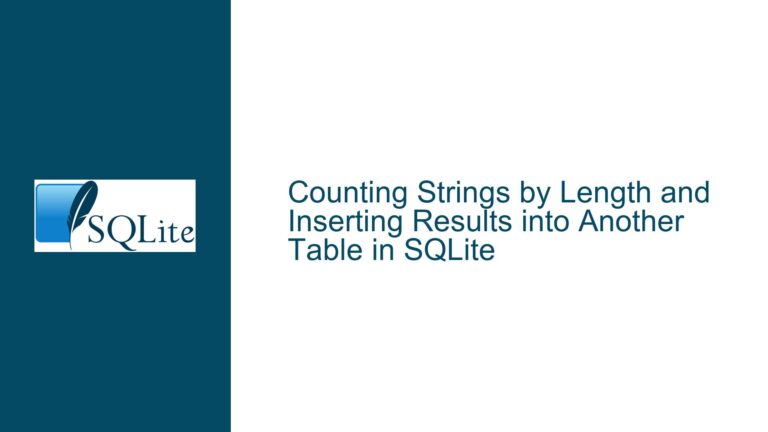RETURNING Clause Behavior with Cascading Deletes in SQLite
Cascading Deletes and RETURNING Clause: The Core Dilemma
The interaction between the RETURNING clause and cascading deletes in SQLite presents a nuanced challenge that hinges on the expectations of database developers and the consistency of SQLite’s behavior with other relational database management systems (RDBMS). The core issue revolves around whether the RETURNING clause should return only the rows directly deleted by the DELETE statement or if it should also include rows deleted indirectly due to cascading foreign key constraints.
Consider the following schema and query:
PRAGMA foreign_keys=on;
CREATE TABLE t1(
a INTEGER PRIMARY KEY,
b INTEGER REFERENCES t1 ON DELETE CASCADE
);
INSERT INTO t1(a,b) VALUES(0,null),(1,0),(2,1),(3,2),(4,null);
DELETE FROM t1 WHERE a=0 RETURNING a;
In this example, deleting row 0 from t1 triggers a cascading delete that also removes rows 1, 2, and 3 due to the ON DELETE CASCADE constraint. The question is whether the RETURNING clause should return only row 0 or all four rows (0, 1, 2, and 3).
Arguments for Returning All Rows
One perspective argues that the RETURNING clause should include all rows deleted, whether directly or indirectly. This approach aligns with the principle that developers using the RETURNING clause are likely interested in the full impact of their DELETE operation. If the clause only returns the directly deleted rows, the result becomes dependent on the order of deletions, which can lead to inconsistent and unpredictable behavior. For instance, if the DELETE statement targets multiple rows, the RETURNING output might vary depending on the sequence in which rows are processed and cascading deletes are applied.
Additionally, triggers and other side effects are executed for cascading deletes, suggesting that the RETURNING clause should similarly reflect these changes. This consistency ensures that developers have a complete view of the operation’s impact, which is particularly useful for debugging, auditing, or undoing changes.
Arguments for Returning Only Directly Deleted Rows
On the other hand, some argue that the RETURNING clause should only report rows directly deleted by the DELETE statement. This approach is rooted in the principle of consistency across tables. Since the RETURNING clause cannot report rows deleted in other tables due to cascading deletes, it should not report indirectly deleted rows in the same table either. Treating all tables uniformly simplifies the mental model for developers and aligns SQLite’s behavior with other RDBMS like PostgreSQL.
Moreover, the primary purpose of the RETURNING clause is to provide feedback on the rows explicitly targeted by the DELETE statement. Indirect deletions, such as those caused by cascading constraints, are considered side effects that fall outside the scope of the RETURNING clause. This distinction ensures that the clause remains focused on the direct consequences of the query, reducing complexity and potential confusion.
Implications of Cascading Deletes on RETURNING Clause Behavior
The behavior of the RETURNING clause in the context of cascading deletes has significant implications for database design, application logic, and compatibility with other database systems. Understanding these implications is crucial for making informed decisions about schema design and query construction.
Consistency with Other RDBMS
One of the primary considerations is consistency with other RDBMS, particularly PostgreSQL. PostgreSQL’s behavior, where the RETURNING clause only includes directly deleted rows, has become a de facto standard. Aligning SQLite’s behavior with PostgreSQL ensures that developers can transition between the two systems with minimal friction. This consistency is especially important for applications that may need to support multiple database backends or migrate from one system to another.
Impact on Application Logic
The choice between returning only directly deleted rows or all deleted rows also affects application logic. If the RETURNING clause includes all rows, developers can use it to obtain a comprehensive list of affected rows, which can be useful for tasks like logging, auditing, or undoing changes. However, this approach requires careful handling of the returned data, as it may include rows that were not explicitly targeted by the DELETE statement.
Conversely, if the RETURNING clause only includes directly deleted rows, developers must use additional queries or mechanisms to track cascading deletes. This approach can increase the complexity of the application logic but provides a clearer separation between the direct and indirect effects of the DELETE operation.
Performance Considerations
The behavior of the RETURNING clause can also impact performance. Returning all deleted rows, including those affected by cascading deletes, may require additional processing to gather and return the data. This overhead can be significant in scenarios with complex cascading relationships or large datasets. On the other hand, limiting the RETURNING clause to directly deleted rows reduces the computational burden and ensures that the operation remains efficient.
Resolving the Dilemma: Best Practices and Future Directions
Given the competing arguments and implications, resolving the dilemma requires a balanced approach that considers both developer expectations and system consistency. Below, we explore best practices for handling cascading deletes with the RETURNING clause and discuss potential future enhancements to SQLite.
Current Best Practices
As of now, SQLite aligns with PostgreSQL’s behavior, where the RETURNING clause only includes directly deleted rows. This approach ensures consistency with other RDBMS and simplifies the mental model for developers. To handle cascading deletes, developers can use additional mechanisms such as triggers, the sqlite3_changes() function, or the session extension to track changes across tables.
For example, the sqlite3_changes() function can be used to determine the total number of rows affected by a DELETE operation, including those deleted due to cascading constraints. However, this function does not provide details about the specific rows deleted. For more granular tracking, developers can use triggers to log deletions or the session extension to capture changes made by a statement.
Future Enhancements
To address the limitations of the current approach, future versions of SQLite could introduce enhancements that provide more flexibility in handling cascading deletes with the RETURNING clause. One potential enhancement is the introduction of a RECURSIVE keyword, as suggested by Richard Hipp. This keyword would allow developers to opt into returning rows affected by cascading deletes within the same table, providing a more comprehensive view of the operation’s impact.
For example:
DELETE FROM t1 WHERE a=0 RETURNING RECURSIVE *;
This syntax would return all rows deleted, including those affected by cascading deletes, while the traditional syntax would continue to return only directly deleted rows. This approach offers the best of both worlds, allowing developers to choose the behavior that best suits their needs.
Another potential enhancement is the introduction of a pragma or configuration option to control the behavior of the RETURNING clause. For instance:
PRAGMA returning_indirectly_touched_rows=yes;
This pragma would enable or disable the inclusion of indirectly deleted rows in the RETURNING clause, providing developers with greater control over the operation’s output.
Practical Recommendations
In the meantime, developers can adopt the following practical recommendations to handle cascading deletes effectively:
Use Triggers for Logging: Implement triggers to log deletions and capture the full impact of cascading deletes. This approach provides a detailed record of changes without relying on the
RETURNINGclause.Leverage the Session Extension: Use the session extension to track changes made by a statement, including those caused by cascading deletes. This extension provides a powerful mechanism for capturing and analyzing changes across tables.
Combine
RETURNINGwith Additional Queries: Use theRETURNINGclause to capture directly deleted rows and execute additional queries to identify rows affected by cascading deletes. This approach ensures that developers have a complete view of the operation’s impact.Document Behavior Clearly: Clearly document the behavior of the
RETURNINGclause in your application’s codebase to ensure that all team members understand its limitations and implications.
By following these recommendations, developers can effectively manage cascading deletes and ensure that their applications remain robust and maintainable.
Conclusion
The interaction between the RETURNING clause and cascading deletes in SQLite presents a complex challenge that requires careful consideration of developer expectations, system consistency, and performance implications. While the current behavior aligns with PostgreSQL and simplifies the mental model for developers, future enhancements could provide greater flexibility and control over the operation’s output.
By adopting best practices and leveraging available tools and mechanisms, developers can effectively handle cascading deletes and ensure that their applications remain robust and maintainable. As SQLite continues to evolve, enhancements to the RETURNING clause and related features will further empower developers to build efficient and reliable database-driven applications.






